Ever wondered if your trusty vinegar could be the secret to reviving your wood surfaces? Dive into the world of Vinegar On Wood with us and discover its surprising versatility!
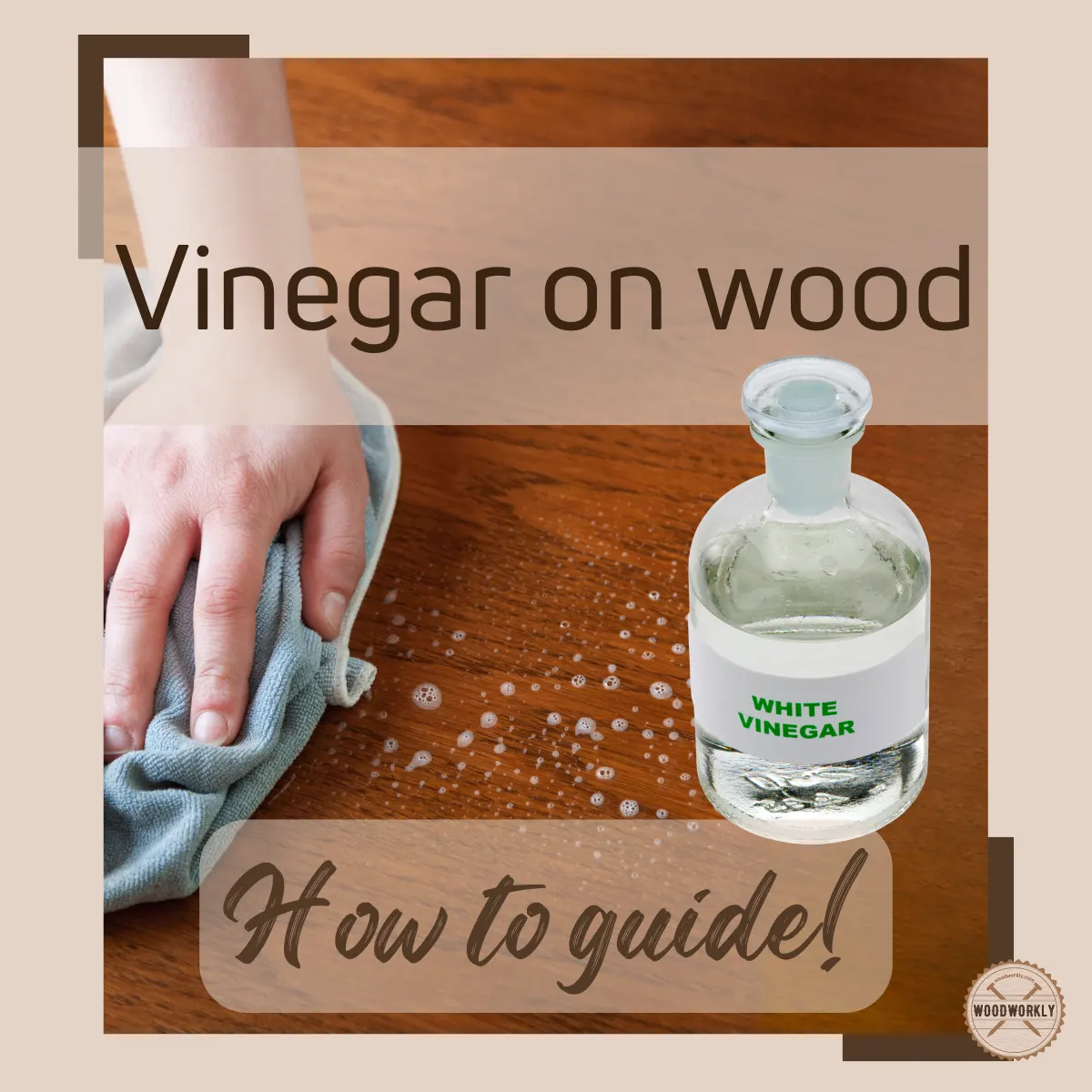
We all know that vinegar is an acidic compound used in cooking, cleaning, and baking applications.
But have you ever considered using vinegar on wood or cleaning wood with vinegar? Will it damage the wood?

I’ve explored this topic extensively, seeking advice from experts to identify the best ways to apply vinegar on wood.
This research has provided insights on how to use it properly to achieve the desired results.
So, let’s find out, Can you use vinegar on wood?
Yes, you can use vinegar on wood. Dilute white vinegar with water (equal parts) for cleaning. Apply with a soft cloth, gently rub in the direction of the wood grain, and wipe dry. Avoid using undiluted vinegar to prevent damage to the wood’s finish.
But that’s a quick snapshot and there’s a lot more to know!
So, in this article, I’ll explore what kind of vinegar you should use on wood, what does vinegar to wood, how to use vinegar on wood, and a lot more.
Furthermore, I’ll answer some frequently asked questions as well.
Just keep reading!
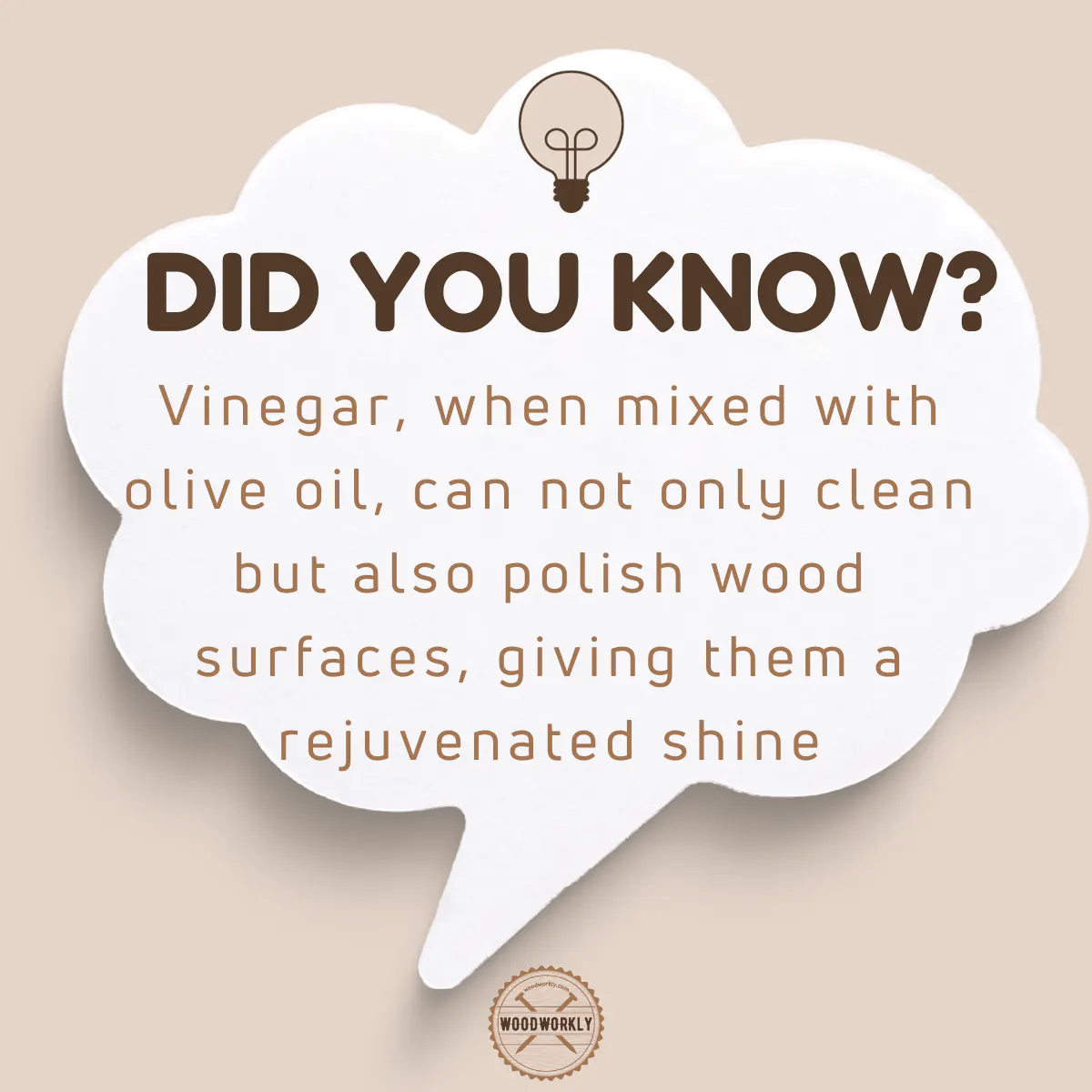
What Kind Of Vinegar Do You Use On Wood?
White vinegar is the type of vinegar you should use on wood. because it is a non-toxic cleaning compound made from a diluted form of acetic acid combined with starches and sugars.
Being colorless, it does not leave any residue behind.
White vinegar is an effective product for removing dust and dirt from furniture and cleaning it.
Alternatively, you can use white vinegar to polish wooden surfaces.
Compared to most wood cleaning products on the market, white vinegar is less expensive.
You can also use white vinegar on painted, varnished, or lacquered wood surfaces after mixing it with olive oil or water.
However, never apply undiluted white vinegar directly to a wooden surface, as it can damage the finish and leave difficult-to-remove water marks.
Always use a diluted version.
To prepare a cleaning solution, mix one cup of white vinegar with four cups of warm water and one cup of olive oil.
Dip a moistened cloth in this mixture and rub it in a circular motion on the wood to remove dust, and dirt, and polish the surfaces.
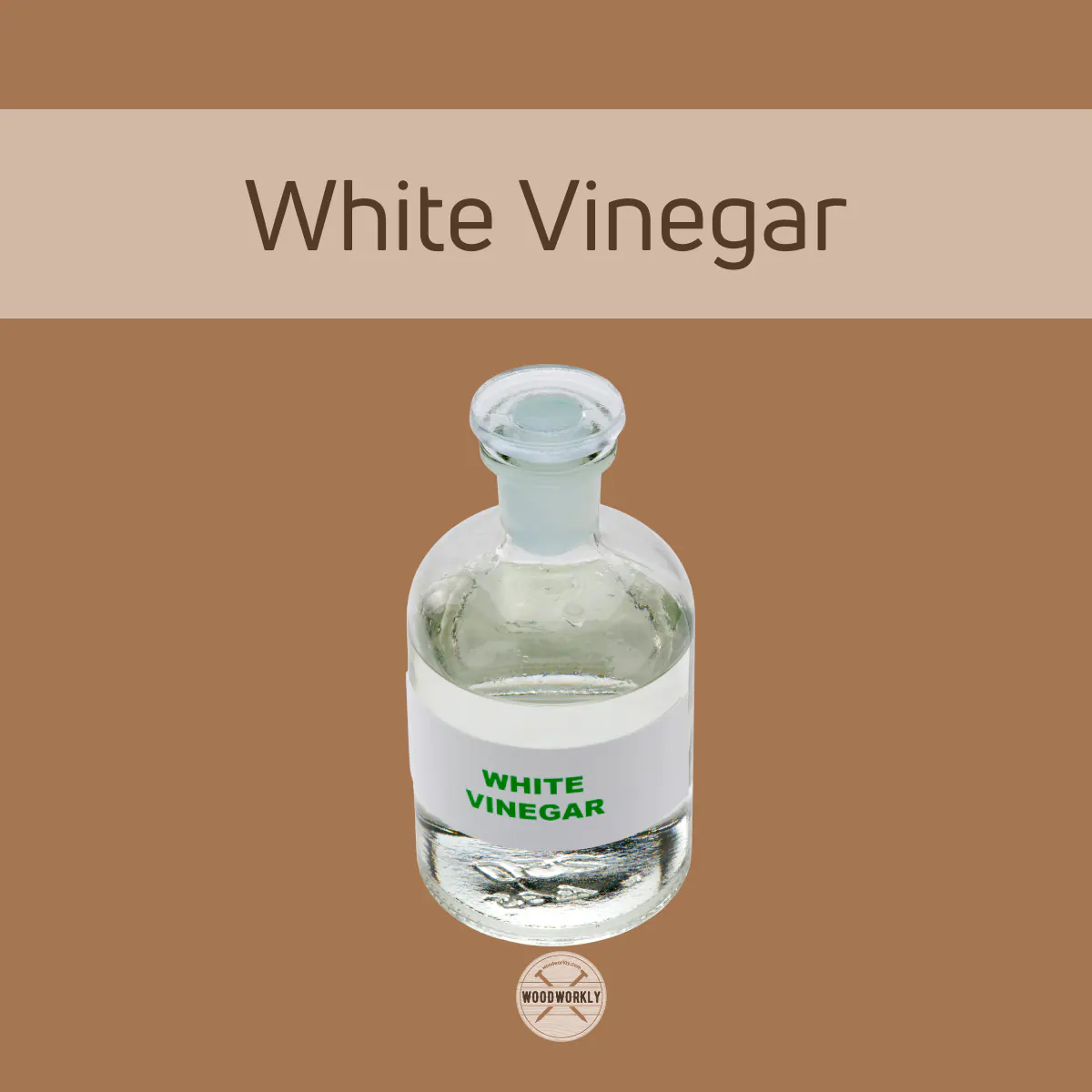
So, let’s see what white vinegar does to your wooden surfaces,
What Does White Vinegar Do To Wood?
Basically, white vinegar is able to remove dust and dirt from the wooden surface and clean the wood and it can polish the wooden surfaces and give a glossy effect to the wood with a fresh look.
White vinegar is also able to remove superficial stains that are difficult to remove by regular cleaning agents and you can use it for deep cleaning the wood as well.
Using the correct ratio of white vinegar is essential to clean the wood without damaging the finish.
Cleaning with white vinegar is a green alternative to toxic cleaning products.
Benefits of White Vinegar on Wood
- Clean the wood by removing dust and dirt
- Polish the wood by giving a shinning effect with a fresh look
- Able to remove liquid stains from wood
- Cost-effective
- Non-toxic
- Easy to use
- Deodorizing
- Able to remove rust by placing handles and drawers in a cup of white vinegar
If there are ring marks on your wood caused by glass or pots, you can remove them immediately with white vinegar with a cotton ball to bring the fresh wood back.
As you can see there are lots of advantages of using white vinegar in wood over other artificial chemical products which are also not environmentally friendly.
White vinegar is able to restore wood by cleaning dust and dirt and it can polish the surface by giving a shiny attractive look to the furniture and woodwork.
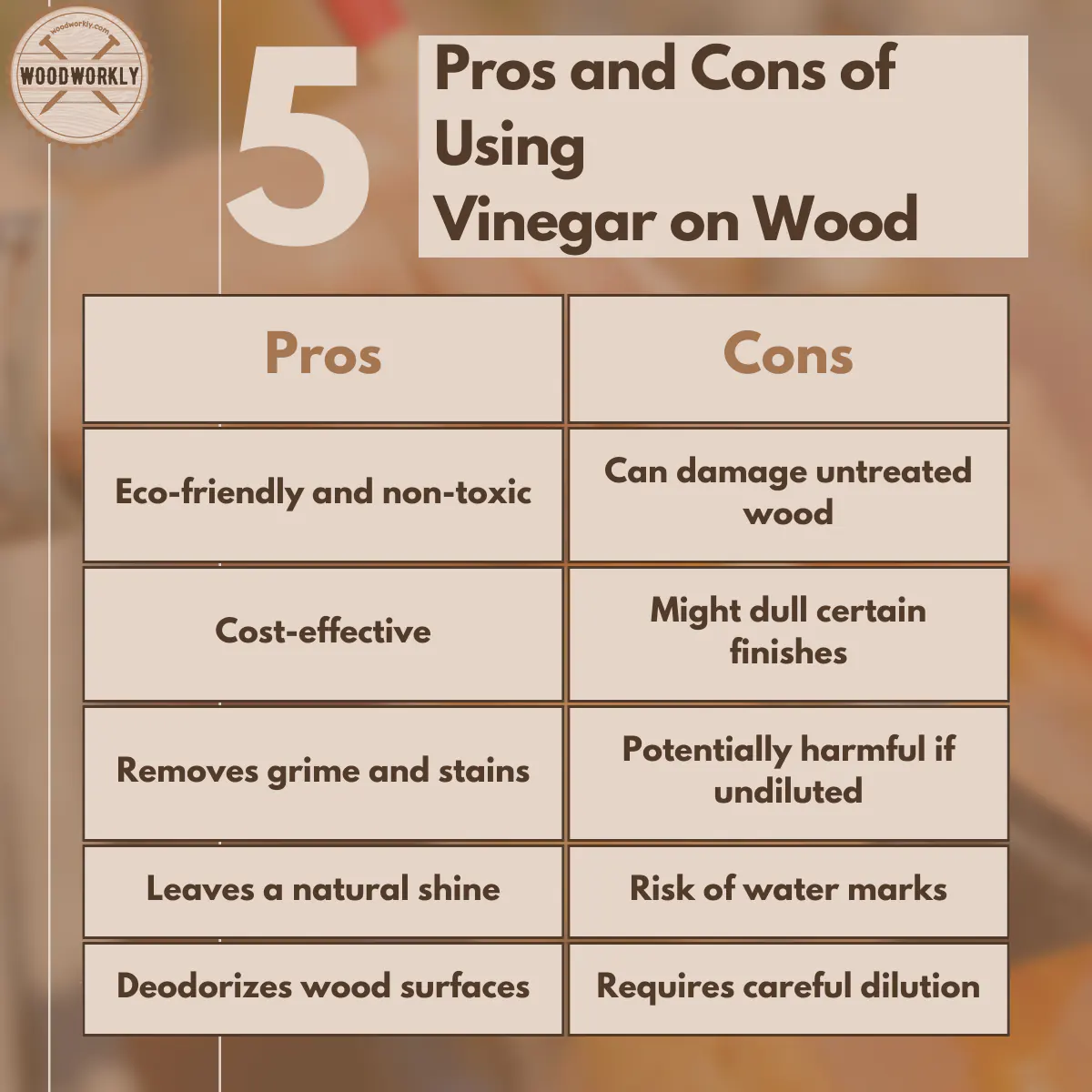
Let’s see how to use vinegar on wood.
Use Cases of Vinegar on Wood
You can use vinegar on wood to clean the wood or to polish the wood. Even though cleaning and polishing wood using vinegar follows the same procedure, mixture preparation is a little bit different from each other.
Here are the main uses of vinegar on wood,
- For cleaning
- For polishing
- For bending wood
You can basically use vinegar on untreated, lacquered, varnished, or painted wood to clean them and remove the current finish on them.
In each and every application method you need to be focused on making the mixture of white vinegar, water, and olive oil.
For some finishes only a little amount of white vinegar is sufficient, but others don’t.
The application procedure is almost the same.
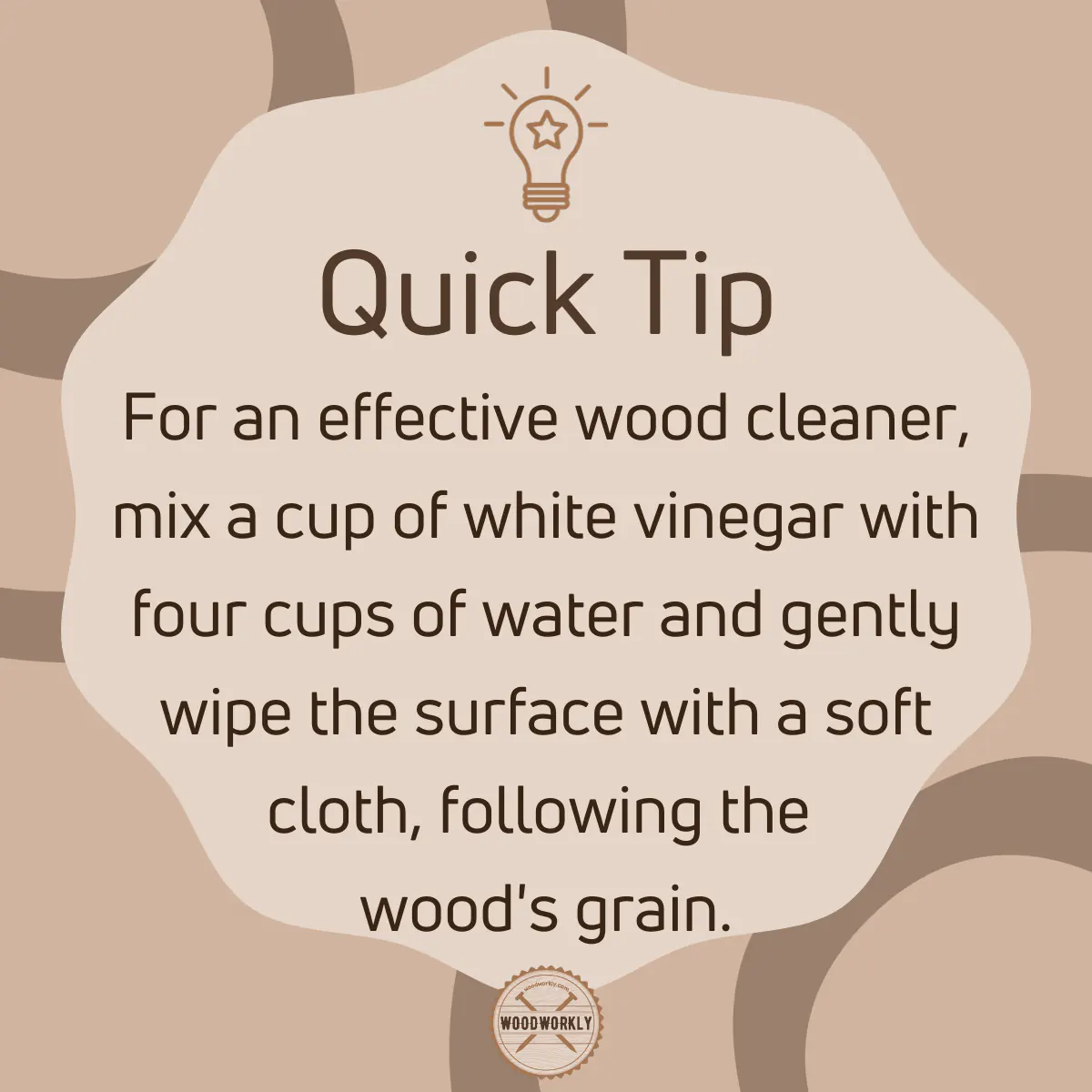
So, in order to get a better understanding, first let’s see how to use vinegar for wood cleaning.
How To Use Vinegar On Wood For Cleaning?
You can use vinegar for cleaning any wood surface including indoor furniture, outdoor furniture, wood countertops, wood carvings, and flooring.
Here’s how to clean wood using vinegar.
Supplies You Will Need,
- Cup of white vinegar
- Cup of water
- Cotton cloth
- Dry cotton cloth
- Tablespoon
- Bucket
- Fork
Here’s the procedure for cleaning wood using vinegar,
- Make the mixture of white vinegar and water
- Test the vinegar solution on the wood
- Dip a cotton cloth in the vinegar solution
- Rub vinegar solution on the wood
- Let the wood completely dry
So, let’s discuss each of the above steps in detail to get a good understanding of cleaning wood with vinegar.
1. Make The Mixture Of White Vinegar And Water
First, you need to add one cup of water into the bucket and then pour 3 tablespoons of white vinegar into it. Or 2 cups of water with 6 tablespoons of white vinegar. This amount can differ on the wood area you need to cover.
The vinegar and water mixing ratio should be 1:3 when cleaning the wood.
After adding vinegar to the water, mix them with a fork.
Make sure not to give air bubbles to trap inside the vinegar solution when mixing since they create troubles for the mixing process.
Now your vinegar solution is ready to clean the wood.
2. Test The Vinegar Solution On Wood
Before heading into the main project, you should test the prepared vinegar solution with an inconspicuous area of wood to see how it reacts with the wooden surface.
If you made a mistake during the mixing process, you will be able to identify the mistake by testing in this step. This will stop the damage that was about to happen on the main project.
Take a clean cotton cloth and moisten it by dipping it into the vinegar solution and rub an inconspicuous small area on wood in a circular motion and wait for a few minutes until the wood area dries completely.
Or buff the surface dry with a clean cloth.
Then check the applied surface for any issues.
If you notice any watermarks or if the finished or painted surface is damaged, you should immediately stop the application process and start to work again on the mixing process.
If the applied area is ruined with your pre-prepared vinegar solution, make a new vinegar solution by reducing the vinegar portion in water.
For example, try to make a new vinegar solution by adding 2 tablespoons of vinegar instead of 3 into a cup of water. The acidity of vinegar can be harmful to some woods. So, try to reduce vinegar amounts.
If nothing worked well, better to contact the manufacturer of vinegar through their website or go for another vinegar manufacturer.
Always use quality products, especially when working with your expensive wood furniture.
If you don’t notice any negative impact on the area you tested, your prepared vinegar solution is good to go for the whole cleaning process.
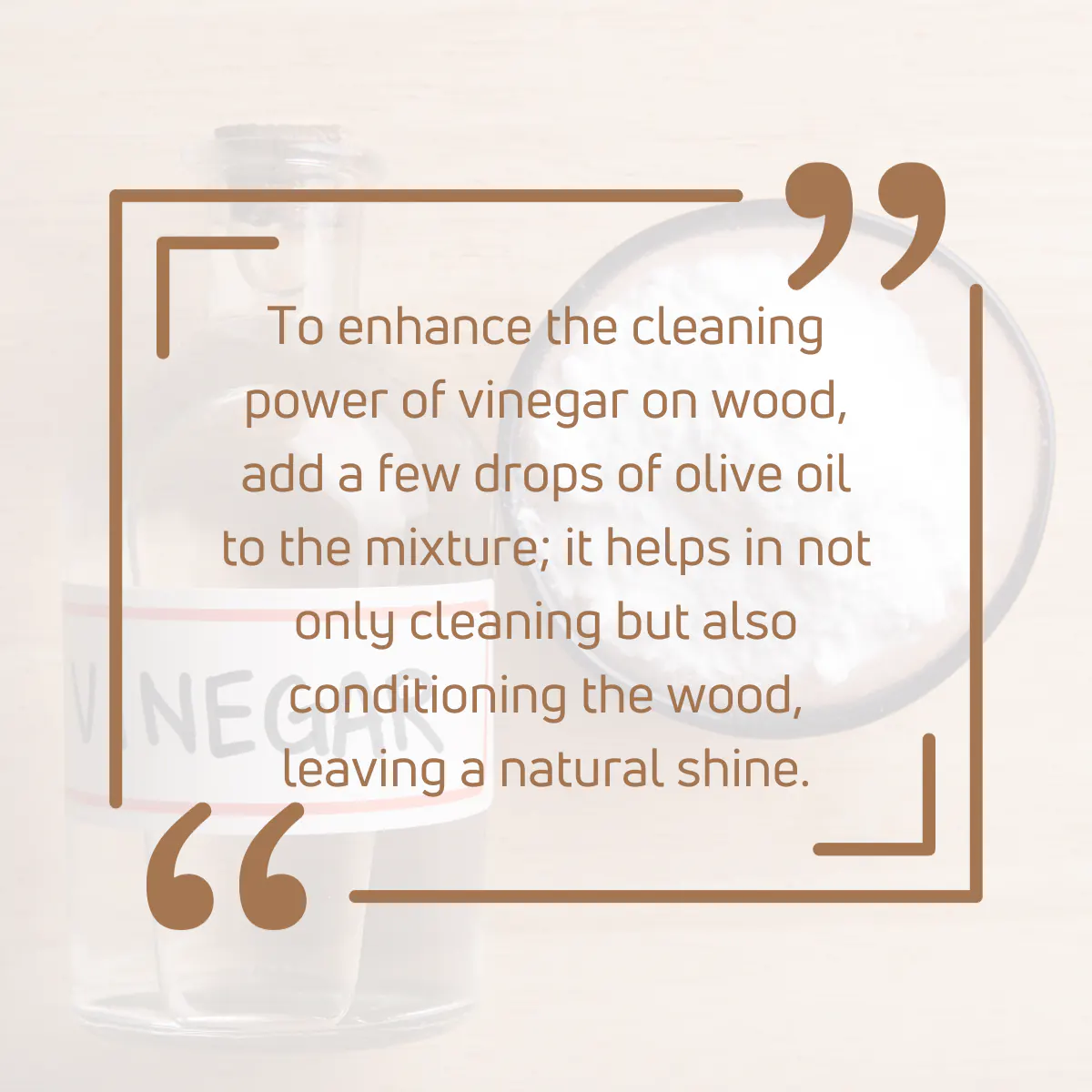
3. Dip Cotton Cloth in Vinegar Solution
Take a clean cotton cloth and dip it in the bucket of vinegar solution. Then wring out the cloth to stop the oversaturation of the vinegar solution. We only need to moisten the cloth.
Applying excessive amounts of vinegar on wood can damage the wood and ruin the wood finish. Therefore, spraying vinegar on wood surfaces is strictly prohibited.
4. Rub Vinegar Solution On Wood
After dipping a cotton cloth in vinegar solution and wringing it out, place it on the wooden surface and rub it in circular motions.
Rub along the direction of the wood grain to remove the dust and dirt particles quite easily and to clean the wood properly. This will give a shiny effect to the wood.
Push the cloth wood grain to get better results at cleaning.
If you notice the cotton cloth is getting dirty while rubbing on, rinse the cloth or shit to a new cotton cloth and do the rubbing process again after dipping it in the vinegar solution.
For lacquered, varnished, or painted surfaces, you need to wipe off the excess vinegar solution immediately on the wood with a soft cloth since staying vinegar solution on the finished surface for too long can damage the finish.
5. Let The Wood Completely Dry
After covering the whole wooden surface with the vinegar solution, take a clean cotton cloth and buff the wood in a circular motion to remove excess vinegar solution.
When buffing the wood with cloth, you may notice some areas that are still green and haven’t been cleaned properly.
You can re-apply vinegar solution on those areas by dipping cloth into the solution and rubbing those areas. Then buff the excess moisture using a clean dry cotton cloth.
Now let the wooden surface dry completely. you’ll about to see super clean, fresh- and nice-looking furniture after cleaning the wood with vinegar.
Always follow correct ratios, and portions to get the maximum benefits of cleaning apart from ruining the wood surface.
Test before using vinegar solution and make the mixture by yourself to get the best cleaning results.
That’s how you should clean wood using vinegar. Simple as that!
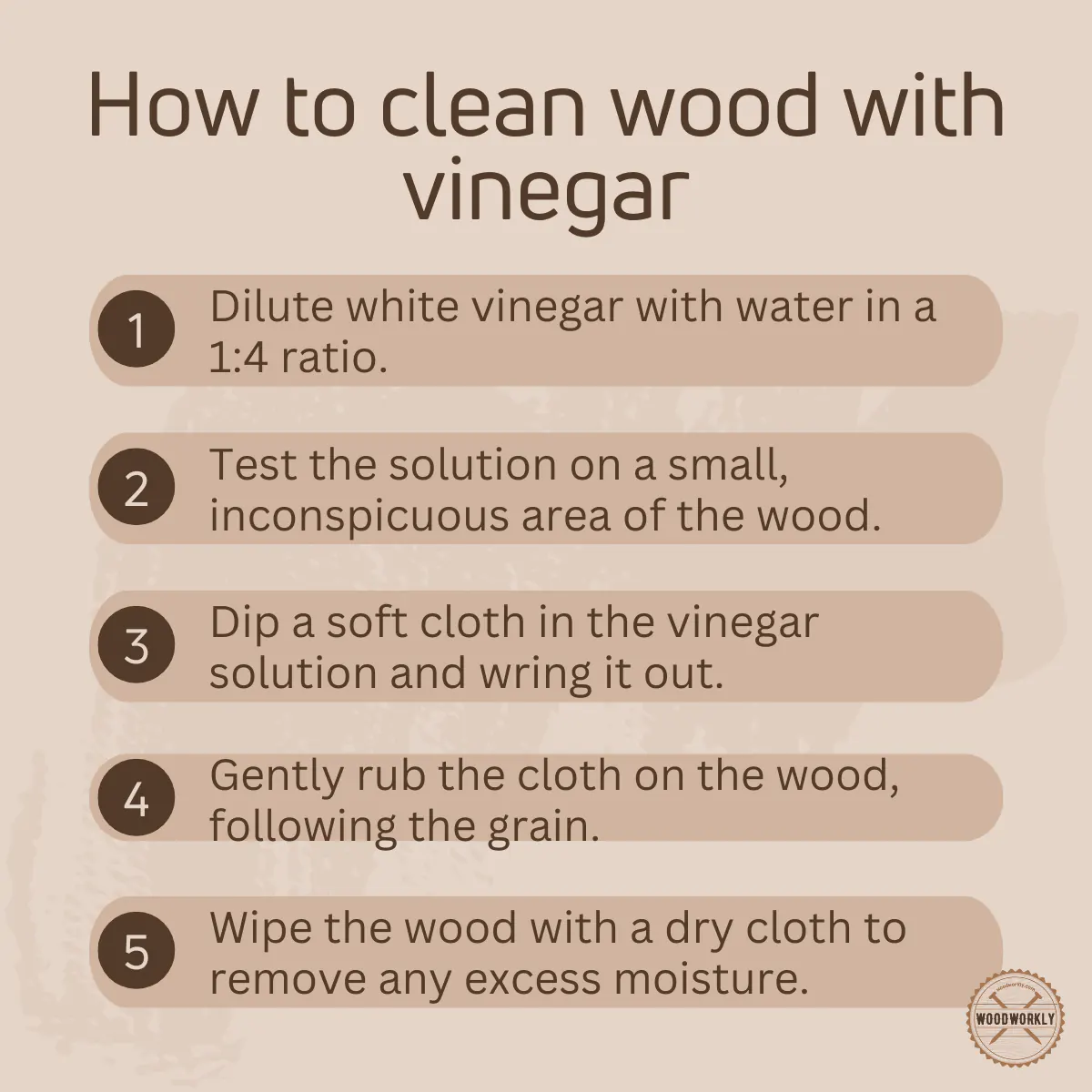
Let’s see how to polish the wood with vinegar using the correct procedure. It is just a little bit different from the cleaning process.
How To Polish Wood with Vinegar?
You can polish the wood with vinegar quite easily. It gives shinning, shiny, and glossy effect to wood furniture and other woodwork.
Polishing wood with vinegar one or two time annually helps to restore wood and bring the wood back to its original fresh appearance.
Here’s how to polish the wood with vinegar,
Supplies You Will Need,
- Cup of white vinegar
- Cup of water
- Cup of olive oil
- Lemon juice or lemon oil
- Cotton cloth
- Dry cotton cloth
- Tablespoon
- Jar with a lid
- Fork
Here are the steps you need to follow when polishing wood with vinegar,
- Make the mixture of white vinegar and olive oil
- Test the vinegar solution on the wood
- Dip a cotton cloth in the vinegar solution
- Rub the moistened cloth on the wood
- Let the wood completely dry
So, let’s discuss each of the above steps in detail to polish wood with vinegar.
1. Make The Mixture Of White Vinegar And Olive Oil
First, you need to mix one part of white vinegar with one part of olive oil in the clean bucket. Then add a small squirt of lemon oil or a squeeze of lemon juice to the mixture and mix them well.
You can add equal amounts of white vinegar and olive oil using a tablespoon and the total volume can differ according to the wood area that you’re going to cover.
Mix the vinegar and olive oil mixture with a small amount of lemon oil well using a fork until you get a thick solution.
Or you can close the lid of the jar and shake the solution thoroughly until they mix completely since they won’t mix well only by using a fork.
Adding lemon oil or a squeeze of lemon juice is an optional step that is useful to penetrate deep into the small cracks on the wood surface to remove the dirt inside the wood. This is useful when polishing old furniture.
Vinegar and olive oil won’t mix properly, but you’ll be able to get a thick solution by mixing and shaking them well for a few minutes.
Now your vinegar solution is ready to polish the wood.
2. Test The Vinegar Solution On Wood
Before heading into the main project directly, you should test the prepared vinegar solution on an inconspicuous area of wood to see how it reacts with the wooden surface.
By doing this you’ll be able to identify whether you have used enough amounts of vinegar and olive oil, did you mix them well, are contaminated things.
Testing is helpful to minimize the damage you are about to do for the main project since you can identify the issues you made in the initial step and correct those immediately.
Dip a cotton cloth in vinegar olive oil solution and rub on an inconspicuous area of wood after wringing it.
Then let the wood absorb the vinegar solution and wipe the excess using a cotton cloth. Then let the wood dry for a few minutes and monitor the applied area for any defects.
If the applied area is damaged or the applied finisher is peeling off, you should immediately stop using the prepared vinegar solution and start to make a new solution by reducing the volume of vinegar.
If nothing works well, better to contact the manufacturer of vinegar or olive oil through their website or go for another manufacturer.
Always use quality products, especially when polishing your expensive wood furniture.
If there are no negative effects appear on the tested area, your prepared vinegar solution is good to cover up the whole wood with no issues.
3. Dip Cotton Cloth In Vinegar Solution
Take a clean cotton cloth and dip it in vinegar olive oil solution and soak it. Then take it out and do wring to remove excess vinegar solution from the cloth.
We just need to moisten the wood with the vinegar solution, not oversaturation because the oversaturation of vinegar results in excess on the wood surface and can damage the wood finish by forming water rings.
4. Rub Moistened Cloth On the Wood
Rub the moistened cloth on the wooden surface you want to polish in a circular motion along the direction of the wood grain.
Polishing along the wood grain is able to give a glossy effect to the wood easily while removing water marks and streaks.
Take a new cloth by dipping and wringing when you notice the cloth, you’re using getting dirty.
Polish gently all over the wood without missing spots.
When polishing lacquered, or painted surfaces, you need to wipe off the excess vinegar solution immediately on the wood with a soft cloth since staying vinegar solution on the finished surface for too long can peel off the finish.
5. Let The Wood Dry Completely
After polishing the wood properly using vinegar, you need to remove excess moisture using a dry, clean cotton cloth before it stay on the wood for so long.
Buff the wood using a cotton cloth in a circular motion.
Letting vinegar solution stain on wood for so long can damage the wood and leave water marks on the wood.
These watermarks appear due to changing the wood color chemically and hence are so difficult to restore.
Finally, let the wood dry for a few minutes and see how the wood is getting nice, clean, deep shiny wood surface.
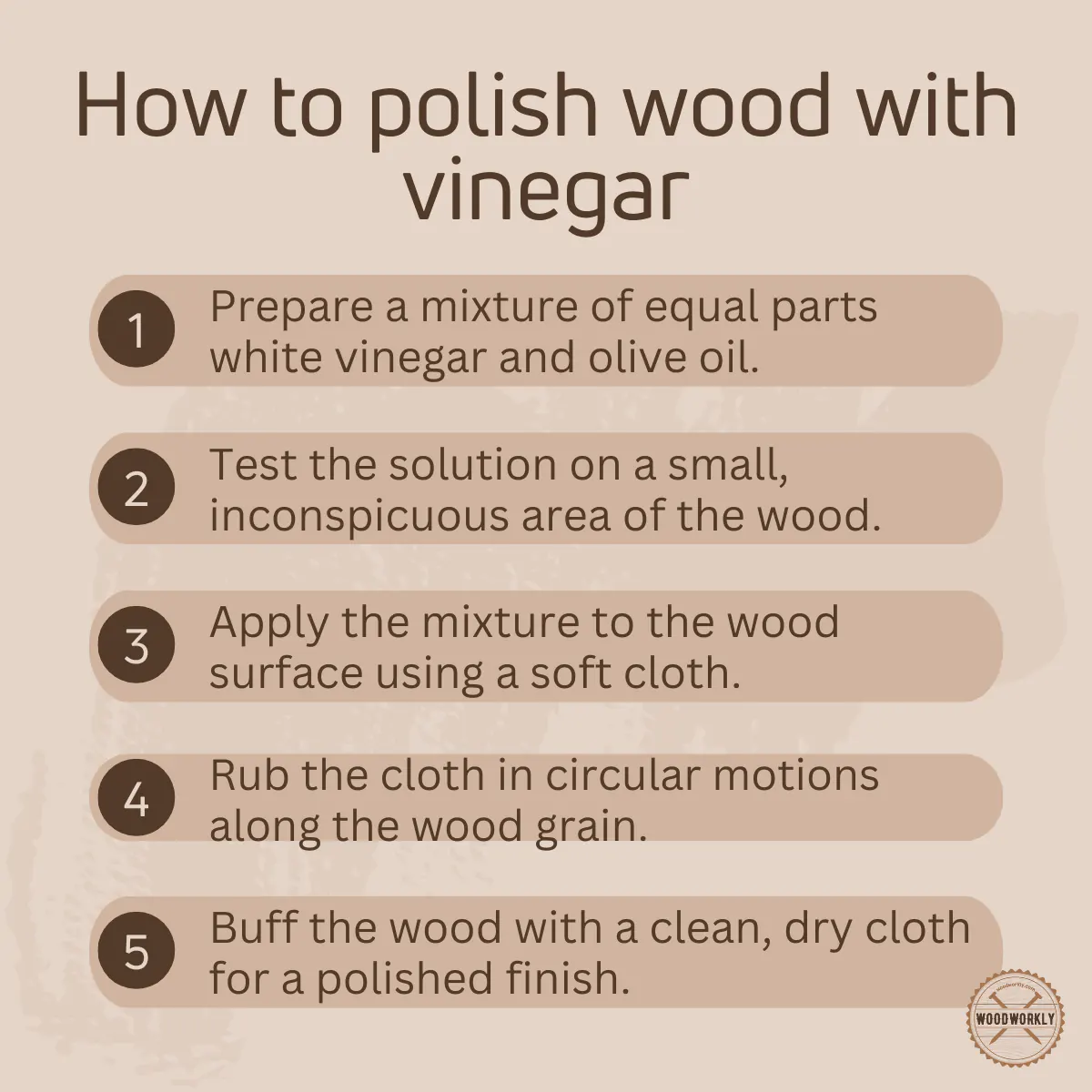
Polish the wood at least two times per year using vinegar to keep the glossy effect with a fresh look on your wooden furniture without losing it for so long.
Regular polishing makes the wood fresh and prevents it from looking dull, dry, and worn.
How to Remove Varnish from Wood with Vinegar?
Removing varnish from wood using vinegar is an effective, eco-friendly alternative to chemical strippers.
Vinegar, particularly white vinegar, is known for its acidic properties that can break down old varnish.
Here’s a detailed guide on how to do it:
1. Prepare Your Workspace
- Choose a Well-Ventilated Area: Work in a space with good airflow to avoid inhaling fumes.
- Lay Down Protective Coverings: Use drop cloths or old newspapers to protect surrounding areas from spills.
2. Gather Your Supplies
- White Vinegar: Acts as the primary varnish remover.
- Water: Used to dilute the vinegar.
- A Pot for Boiling Water: To mix with vinegar.
- Protective Gear: Gloves and goggles to protect your skin and eyes.
- Brush or Sponge: For applying the vinegar solution.
- Scraper: A plastic or wooden scraper to gently remove the varnish.
- Clean Cloths: For wiping and cleaning.
3. Create Your Vinegar Solution
- Mix the Vinegar and Water: A common ratio is 50-50, but you can adjust based on the toughness of the varnish.
- Heat the Solution (Optional): Some prefer to use the mixture warm for better effectiveness.
4. Test the Solution
- Apply to a Small Area: Before applying it all over the wood, test it on a small, inconspicuous area.
- Check for Adverse Reactions: Ensure the vinegar solution does not damage the wood.
5. Apply the Vinegar Solution
- Use a Brush or Sponge: Gently apply the vinegar solution to the varnished area.
- Let it Sit: Allow the solution to penetrate the varnish for several minutes.
6. Scrape Off the Varnish
- Gently Scrape: Use a plastic scraper to remove the softened varnish. Be gentle to avoid scratching the wood.
- Work in Small Sections: This gives you more control and prevents the solution from drying out.
7. Wipe and Clean
- Use a Damp Cloth: After scraping, wipe the wood with a clean, damp cloth to remove any vinegar residue.
- Repeat if Necessary: Some stubborn varnish may require a second application.
8. Neutralize the Acid
- Wipe with a Mild Soap Solution: To ensure no acidic residue remains, which could affect the wood over time.
9. Dry and Sand
- Let the Wood Dry Completely: Ensure the wood is fully dry before proceeding with any refinishing.
- Sand the Surface (Optional): For a smoother finish, lightly sand the wood once dry.
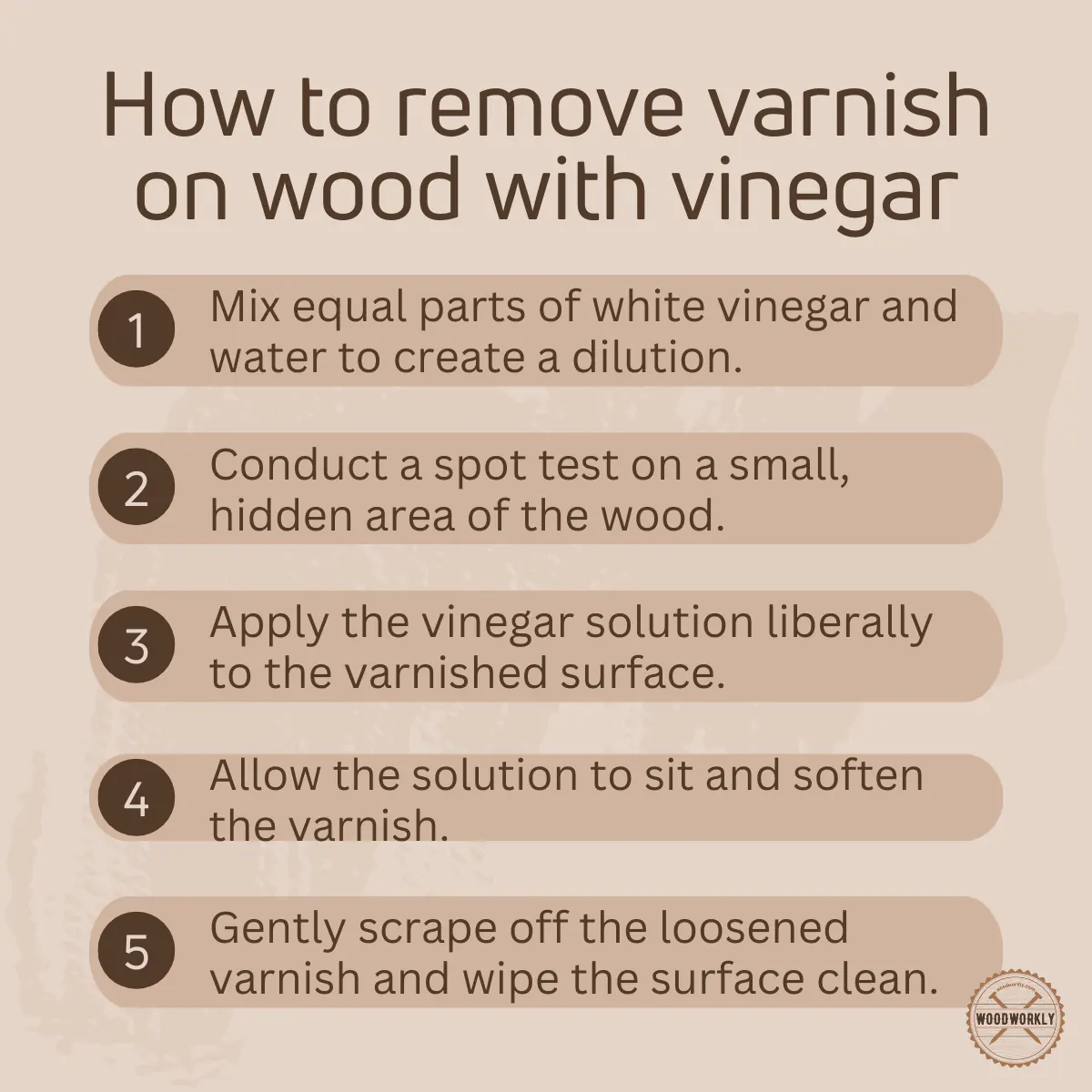
Can You Use Vinegar On Painted Wood?
Yes, you can use vinegar on painted wood to remove dust, and dirt and clean the surface or to polish the paint by giving it an attractive fresh appearance.
Diluted white vinegar does not damage painted wood. But make sure to dilute the vinegar with water or olive oil before using it on painted wood because undiluted vinegar can damage the paint and damage the wood.
Clean painted wood at least two times per year with vinegar to prevent the surface from getting dull and dry appearance.
Here are the steps for using vinegar on painted wood,
- Mix equal amounts of white vinegar and olive oil with 2 cups of warm water in a jar
- Close the lid and shake the jar well to make the vinegar solution
- Test the vinegar solution on a small painted area to see the results
- Dip a cotton cloth in vinegar solution, swell and moisten by wringing it
- Rub moistened cloth gently on the painted surface in a circular motion to clean and polish the surface
- Remove excess moisture using a cotton cloth
- Let the surface dry for one, or two hours
How To Remove Stains and Mold On Wood Using Vinegar
You can remove watermarks, stains, and mold that occur because of liquid splits, wood aging, oil, and grease from finished or untreated wood using vinegar.
Here are the steps for removing stains and mold on wood using vinegar,
- Mix one part of vinegar with 4 parts of water in a jar
- After mixing them properly, add the solution into a bottle of sprayer
- Add a little amount of lemon oil or squeeze of lemon juice to the bottle
- Close the bottle and shake it thoroughly
- Take a lint-free tack cloth and spray the vinegar solution on it
- Moisten the cloth by wringing it lightly
- Rub moistened cloth gently on the wood area with stains or mold in a circular motion to clean and remove stains and mold
- Polish the surface to eliminate the bad odor caused by mold and mildew.
- Shift to a new cloth when you feel the cloth, you’re using getting dirty
- Remove excess moisture using a cotton cloth
- Let the surface dry for one, or two hours
That’s it, folks! Now you know, can you use vinegar on wood and how to use it properly on any wood without damaging or ruining the finish?
Does Vinegar Damage Untreated Wood?
Vinegar does not damage untreated wood when diluted with olive oil or water before applying it. Applying undiluted vinegar on untreated wood can damage the wood due to the acidity of the vinegar.
Use white vinegar on untreated wood after mixing it with olive oil or coconut oil or water.
You can clean the untreated wood and eliminate dust and dirt from the wood. Plus, you can polish the wood and give a shiny effect to the wood that improves the wood’s appearance.
Can You Use Vinegar On Wood Floors?
Never use undiluted vinegar on wood floors since it can leave water marks and ruin the wax finish on wood floors. Vinegar can damage the wood floors if you directly apply or spray it on the floor. Especially for the floors that are wax-finished.
You can use vinegar on wood only after diluting it with warm water or olive oil.
Here’s the procedure for using vinegar on wood floors,
- Mix one part of vinegar with 4 parts of water in a jar
- After mixing them properly, add the solution into a bottle of sprayer
- Add a little amount of lemon oil or squeeze of lemon juice to the bottle
- Close the bottle and shake it thoroughly
- Take a lint-free tack cloth and spray the vinegar solution on it
- Moisten the cloth by wringing it lightly
- Rub moistened cloth gently on the wood floor to remove dust, and dirt and clean the floor
- Polish the wood floor using vinegar solution by gently pulling through the surface
- Shift to a new cloth when you feel the cloth, you’re using getting dirty
- Remove excess moisture using a cotton cloth
- Let the surface dry for one, or two hours
Does Vinegar Turn Wood Grey?
Vinegar is colorless and it doesn’t leave or change the color of the wood.
But vinegar does oxidize the steel wool which causes steel wool rust. The rust will react and dye the vinegar solution making a deep color.
When you apply vinegar solution that dyes due to rust on a wood surface, it will automatically turn into a deep color upon drying. It may turn wood grey or black.
In order to stop wood from turning grey after applying vinegar, use a new product of vinegar and never use rusty steel wool when applying vinegar on wood.
Rust causes wood to turn grey when applying vinegar.
Does Vinegar Make Wood Look Old?
Yes, Vinegar makes the wood look old after applying white vinegar on the wood surface for a few hours or days.
The longer it stays on the surface, the more wood gets an old look.
Some people love to see the wood furniture getting an aged look and some don’t.
If you want to keep the wood furniture in its original color without aging for so long better not to use vinegar for cleaning purposes.
Does White Vinegar Stop Wood Rot?
Yes, white vinegar stops wood rot by stopping the fungus pores from spreading.
White vinegar is a fungicide with antimicrobial properties that prevent fungus activities on wood and prevent the wood from rotting.
Therefore, you can use vinegar to restore rotted wood rather than using artificial chemical compounds like Flex Seal on rotted wood.
Let’s answer some frequently asked questions regarding using vinegar on wood.
FAQs
Can vinegar damage wood surfaces?
Yes, undiluted vinegar can damage wood surfaces by affecting the finish or the wood itself, particularly on untreated or raw wood.
How do you dilute vinegar for use on wood?
To dilute vinegar for wood, mix equal parts of vinegar and water, and for added conditioning, you can include a drop of olive oil or lemon essential oil.
Can I use vinegar on hardwood floors?
Yes, but it should be diluted and used cautiously, as excessive use or high concentrations can damage the floor’s finish.
Is vinegar good for removing stains and odors from wood?
Vinegar can effectively remove stains and odors from wood surfaces, especially those caused by pets.
Does vinegar make wood look old or weathered?
Vinegar can give wood an aged appearance, especially when used in higher concentrations or left on the surface for longer periods.
Did I cover all you wanted to know about: Can You Use Vinegar On Wood?
In this article, I have deeply discussed, whether can you use vinegar on wood by taking the qualities of vinegar, uses of vinegar, how to use vinegar on wood for both polishing and cleaning, and more.
You can use vinegar on wood by mixing white vinegar with olive oil for polishing or white vinegar with water for cleaning. Never use undiluted vinegar on wood since it will leave water marks and damage the wood’s finish. Rub the furniture with moistened cloth in a circular motion after dipping it in vinegar oil mixture.
Furthermore, I’ve answered some frequently asked questions as well.
Hope you have gained good knowledge about using vinegar on wood with this detailed post.
Try to use vinegar on any wood after diluting it with a suitable solvent and see how it helps the wood to live forever with great durability.